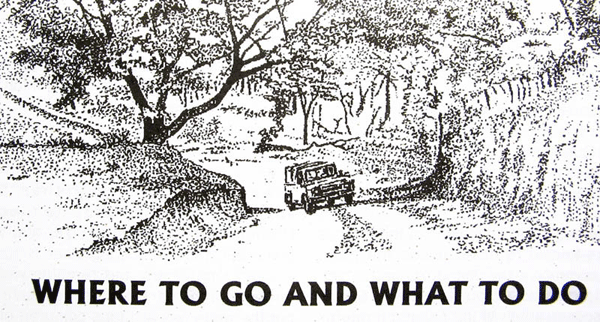
Although the entire National Park is suitable for tourism there are a number of areas sufficiently attractive as to merit special attention - such as the enclaves described above. We shall first consider those that are within easy reach of Gashaka village, before those further afield, in the Northern park sector.
The Bat Forest
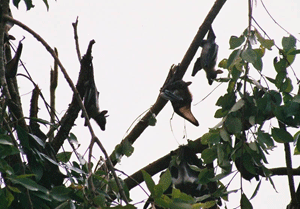
The bat forest, or Kurmin Jemage, so-called because of the large numbers of fruit bats that roost in this eerie and mysterious forest at certain times of the year, can easily be visited from Gashaka village as a day-trip. A variety of other ungulates and primates can also be seen here, including forest animals and animals of the surrounding savannah woodlands.
The Hot Springs
Near to Gashaka village there are hot springs close to Mayo Jiagum and on the Southern park boundary there are hot springs at Matashirip also.
The German Fort
The ruins of the pre-1918 German fort situated on a small hill overlooking Gashaka village are of historical importance, as are the ruins of the German administrative centre near Garbabi village on the road to Beli.
The Hippo Pool
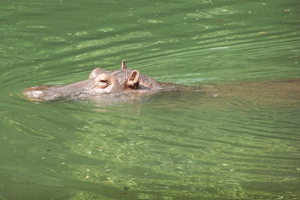
Each dry season the “Hippo Pool” located only a few kilometres upstream of the River Kam bridge provides an ideal opportunity for tourists and researchers alike to study the habits of the hippopotamus at close quarters. These hippos are quite accustomed to such visits, remaining calm and undisturbed throughout.
Although it is quite safe to watch hippos from the bank as they bask peacefully in the water they should be avoided if ever encountered on land. Hippos are unpredictable, and not only with one another, they can suddenly become very aggressive if an intruder gets between them and the water. On land they may look clumsy but they are amazingly agile for their bulk and in an emergency can gallop at speeds up to 30 kilometres per hour.
The Forests at Kwano
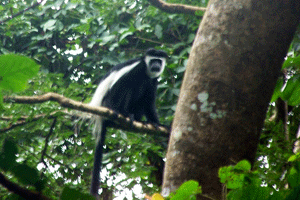
The old abandoned village site of Kwano is an excellent location from which to explore rainforests on the lower slopes of Chappal Tale and beyond. Since the year 2000, a field station for researchers has been erected at this site. The forests here represent some of the best locations for primate watching anywhere in the park. Kwano moreover is easily accessible: a well-worn footpath leads the 13 kilometres from Gashaka village to Kwano (3 hours), passing through savannah woodland and interesting strips of gallery forest. During the dry season, the path can often be navigated by vehicles.
Daneji
Daneji is a remote wilderness are on the Cameroon border, best approached from Toungo through the boundary village of Mayo Butale. From Daneji one can either follow the River Daneji itself down to the junction with the River Yim and return to Toungo via Jiman and Kila (a round trip of 6-8 days from Toungo), or else continue further on into the mountains of Lenga.
The Lakes Around Tipsan
Each dry season large concentrations of animals congregate around several small lakes located in the vicinity of Tipsan. Tipsan is easily accessible from Toungo.
The Mountains of Tepel and Lenga
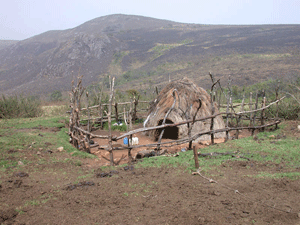
Close to the border with Cameroon, these mountains probably represent the most remote and inaccessible wilderness region of the entire park. Little known and rarely visited except by lion and buffalo, this is the ultimate expedition for the truly adventurous. Best approached from either Daneji or from Gumti village via the River Yim. Frome here, visitors can trek into the Gashaka sector via Filinga enclave, of, alternatively, return down the River Yim to Gashaka via the Sukare valley. Gumti is best approached either from Toungo of by following the Karamti to Tapare to Adagoro (9 hours).
Gangirwal Mountain
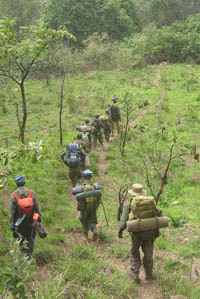
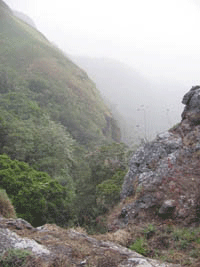
Gangirwal or Chappal Waddi, at 7,936 feet above sea level (2,419 metres) is the highest mountain in Nigeria. Located within the Gotel Mountains in the extreme South-eastern corner of the National Park the summit itself is bisected by the international border with Cameroon. This mountain is a truly wondrous place that has the power to uplift the spirit and delight even the most hardened of travellers.
The upper surface of the mountain carries a flora unique to Nigeria. Most of it is covered with montane grassland and is grazed by cattle from Cameroon. Locally, streams are fringed with narrow strips of montane scrub and a few small patches of forest. The precipitous faces and slopes of the mountain are covered with luxurious montane forest, forests which are known to contain a number of rare trees, butterflies, birds, amphibians, and small mammals. Such forests are found nowhere else in Nigeria.
The mountain can be reached most easily by driving from Serti to the town of Njawai on the North-east corner of the Mambilla plateau (6 hours). This road is difficult and a 4WD vehicle is recommended. From this altitude the ascent of the mountain is relatively easy without much steep climbing involved at all. Continuing to the summit on foot from Njawai the journey is best divided into 2 stages. From Njawai to the small friendly village of Jauro Hammasaleh is a 6 hour walk, from where, refreshed after a good nights sleep, the summit of the mountain can be reached in a further 5 hours walk. For the truly adventurous the mountain can be approached through the park itself, trekking from Gashaka village via Sabere enclave (a round-trip of 8-10 days).
Horse Riding
Certain areas of the park are suitable for horse riding including the Hendu-Shirgu Mountains. Horses and guides can be hired for both of these areas at Selbe and Njawai respectively.
Sport Fishing
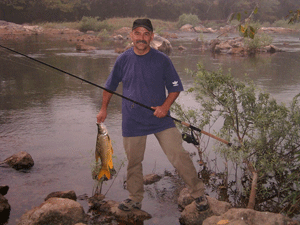
The park's numerous, beautiful rivers are well stocked with fish, including the mighty Nile perch and the spectacular Tiger fish. At times, park authorities might allow catching these fish to then release them again (“sport fishing”). The main season for this activity is during the dry season when the rivers are clear and free from any silt load. The most widely used and successful methods of fishing include “spinning” with the use of artificial lures or spoons, although fly fishing has also been used to effect. .
Some of the fish species likely to be encountered include Tiger fish (Hydrocynus vittatus), Nile perch (Lates niloticus), Large-scaled characin (Brycinus macrolepidotus), Golden barb (Babrus bynni), Catfish (Babrus docmac), Shovel-nosed catfish (Auchenoglanis occidentalis), Sucker fish (Labeo coubie), Electric catfish (Malapterurus electricus)
One of the most common fishes of the park is the catfish, which despite their ugly appearance are among the most highly prized of all food fish in West Africa. Catfish have broad, flattened heads and wide mouths which bear well-developed barbels or “whiskers” from where they have acquired their popular name. They eat almost anything found in a river: fish, mud, rotten vegetation and insects. Catfish possess special accessory breathing organs which not only allow catfish to live in stagnant ponds but also to travel over damp ground in their migrations to new pools.
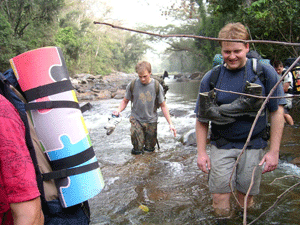
The largest fish in the park is undoubtedly the enormous Nile perch, with specimens 2 metres long and weighing 80 kilograms or more not unknown. Locally they are known as “giwan ruwa” or the elephant of the water. The most unusual fish of the park is the electric fish, capable of delivering an electric shock to anything foolish enough to stray within its reach. Primarily a defence mechanism rather than one of attack, the electricity generated is not sufficiently strong enough to be dangerous to man, although it is rather unpleasant. All kinds of magical properties are attributed to this fish by local people.
In total more than fifty different species of fish have been recorded from the park including the recent discovery of two species entirely new to science from the genera Bryconaethiops and Gobiocichla .
